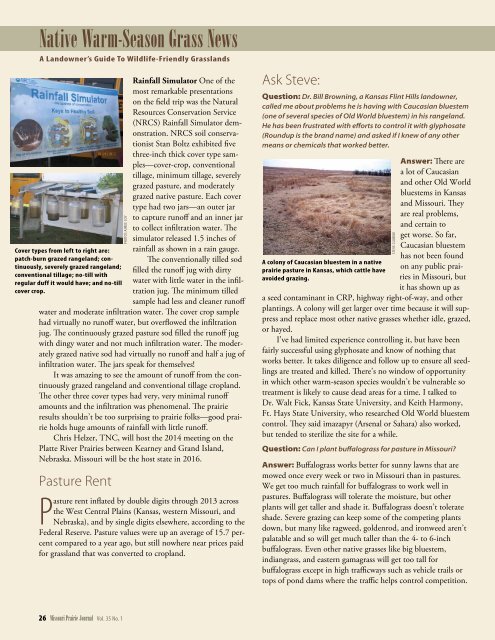l4c9lj6
l4c9lj6
l4c9lj6
You also want an ePaper? Increase the reach of your titles
YUMPU automatically turns print PDFs into web optimized ePapers that Google loves.
Native Warm-Season Grass News<br />
A Landowner’s Guide To Wildlife-Friendly Grasslands<br />
Cover types from left to right are:<br />
patch-burn grazed rangeland; continuously,<br />
severely grazed rangeland;<br />
conventional tillage; no-till with<br />
regular duff it would have; and no-till<br />
cover crop.<br />
Rainfall Simulator One of the<br />
most remarkable presentations<br />
on the field trip was the Natural<br />
Resources Conservation Service<br />
(NRCS) Rainfall Simulator demonstration.<br />
NRCS soil conservationist<br />
Stan Boltz exhibited five<br />
three-inch thick cover type samples—cover-crop,<br />
conventional<br />
tillage, minimum tillage, severely<br />
grazed pasture, and moderately<br />
grazed native pasture. Each cover<br />
type had two jars—an outer jar<br />
to capture runoff and an inner jar<br />
to collect infiltration water. The<br />
simulator released 1.5 inches of<br />
rainfall as shown in a rain gauge.<br />
The conventionally tilled sod<br />
filled the runoff jug with dirty<br />
water with little water in the infiltration<br />
jug. The minimum tilled<br />
sample had less and cleaner runoff<br />
water and moderate infiltration water. The cover crop sample<br />
had virtually no runoff water, but overflowed the infiltration<br />
jug. The continuously grazed pasture sod filled the runoff jug<br />
with dingy water and not much infiltration water. The moderately<br />
grazed native sod had virtually no runoff and half a jug of<br />
infiltration water. The jars speak for themselves!<br />
It was amazing to see the amount of runoff from the continuously<br />
grazed rangeland and conventional tillage cropland.<br />
The other three cover types had very, very minimal runoff<br />
amounts and the infiltration was phenomenal. The prairie<br />
results shouldn’t be too surprising to prairie folks—good prairie<br />
holds huge amounts of rainfall with little runoff.<br />
Chris Helzer, TNC, will host the 2014 meeting on the<br />
Platte River Prairies between Kearney and Grand Island,<br />
Nebraska. Missouri will be the host state in 2016.<br />
Pasture Rent<br />
Photos Aimee Coy<br />
Pasture rent inflated by double digits through 2013 across<br />
the West Central Plains (Kansas, western Missouri, and<br />
Nebraska), and by single digits elsewhere, according to the<br />
Federal Reserve. Pasture values were up an average of 15.7 percent<br />
compared to a year ago, but still nowhere near prices paid<br />
for grassland that was converted to cropland.<br />
Ask Steve:<br />
Question: Dr. Bill Browning, a Kansas Flint Hills landowner,<br />
called me about problems he is having with Caucasian bluestem<br />
(one of several species of Old World bluestem) in his rangeland.<br />
He has been frustrated with efforts to control it with glyphosate<br />
(Roundup is the brand name) and asked if I knew of any other<br />
means or chemicals that worked better.<br />
A colony of Caucasian bluestem in a native<br />
prairie pasture in Kansas, which cattle have<br />
avoided grazing.<br />
Answer: There are<br />
a lot of Caucasian<br />
and other Old World<br />
bluestems in Kansas<br />
and Missouri. They<br />
are real problems,<br />
and certain to<br />
get worse. So far,<br />
Caucasian bluestem<br />
has not been found<br />
on any public prairies<br />
in Missouri, but<br />
it has shown up as<br />
a seed contaminant in CRP, highway right-of-way, and other<br />
plantings. A colony will get larger over time because it will suppress<br />
and replace most other native grasses whether idle, grazed,<br />
or hayed.<br />
I’ve had limited experience controlling it, but have been<br />
fairly successful using glyphosate and know of nothing that<br />
works better. It takes diligence and follow up to ensure all seedlings<br />
are treated and killed. There’s no window of opportunity<br />
in which other warm-season species wouldn’t be vulnerable so<br />
treatment is likely to cause dead areas for a time. I talked to<br />
Dr. Walt Fick, Kansas State University, and Keith Harmony,<br />
Ft. Hays State University, who researched Old World bluestem<br />
control. They said imazapyr (Arsenal or Sahara) also worked,<br />
but tended to sterilize the site for a while.<br />
Question: Can I plant buffalograss for pasture in Missouri?<br />
Answer: Buffalograss works better for sunny lawns that are<br />
mowed once every week or two in Missouri than in pastures.<br />
We get too much rainfall for buffalograss to work well in<br />
pastures. Buffalograss will tolerate the moisture, but other<br />
plants will get taller and shade it. Buffalograss doesn’t tolerate<br />
shade. Severe grazing can keep some of the competing plants<br />
down, but many like ragweed, goldenrod, and ironweed aren’t<br />
palatable and so will get much taller than the 4- to 6-inch<br />
buffalograss. Even other native grasses like big bluestem,<br />
indiangrass, and eastern gamagrass will get too tall for<br />
buffalograss except in high trafficways such as vehicle trails or<br />
tops of pond dams where the traffic helps control competition.<br />
Steve Clubine<br />
26 Missouri Prairie Journal Vol. 35 No. 1


